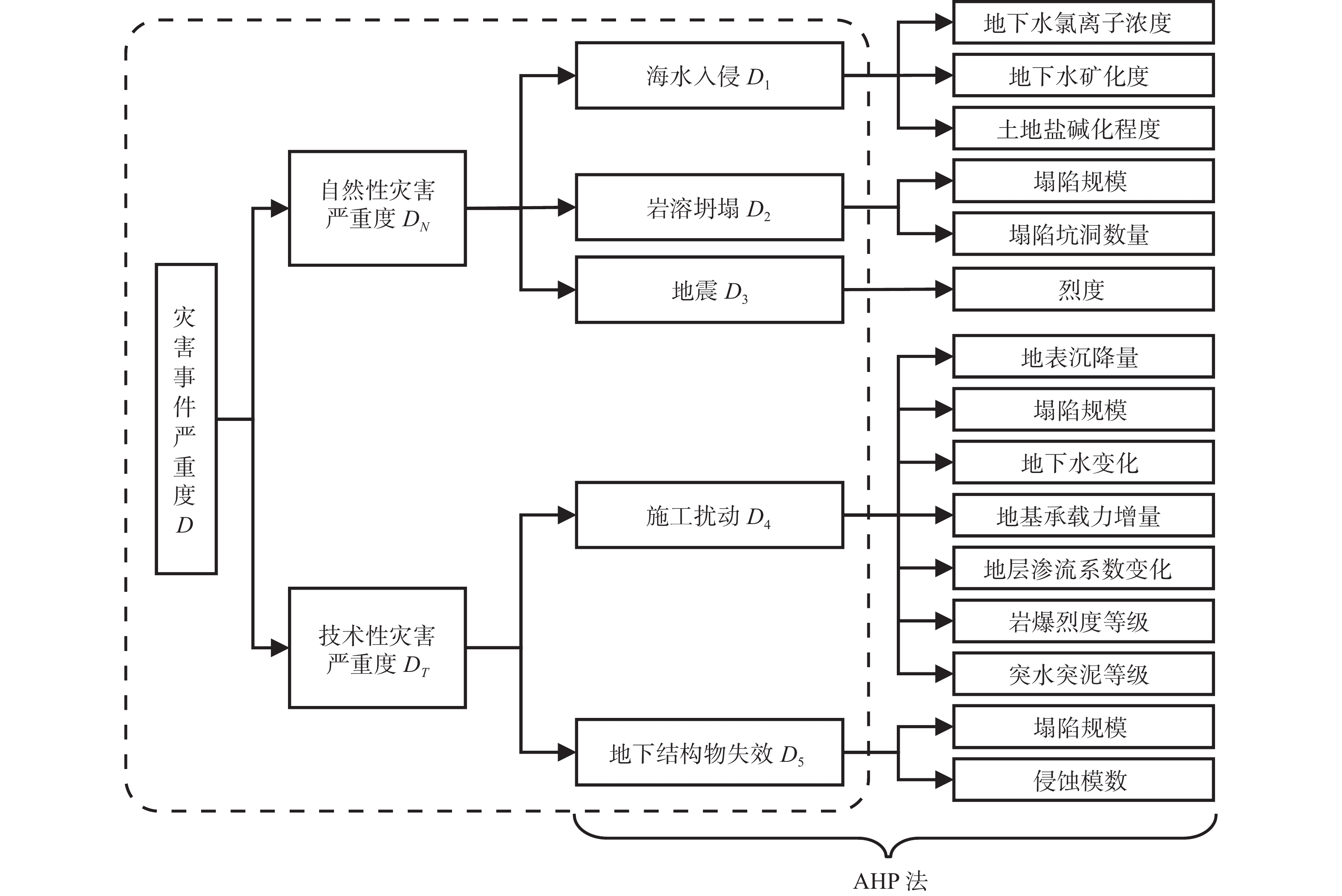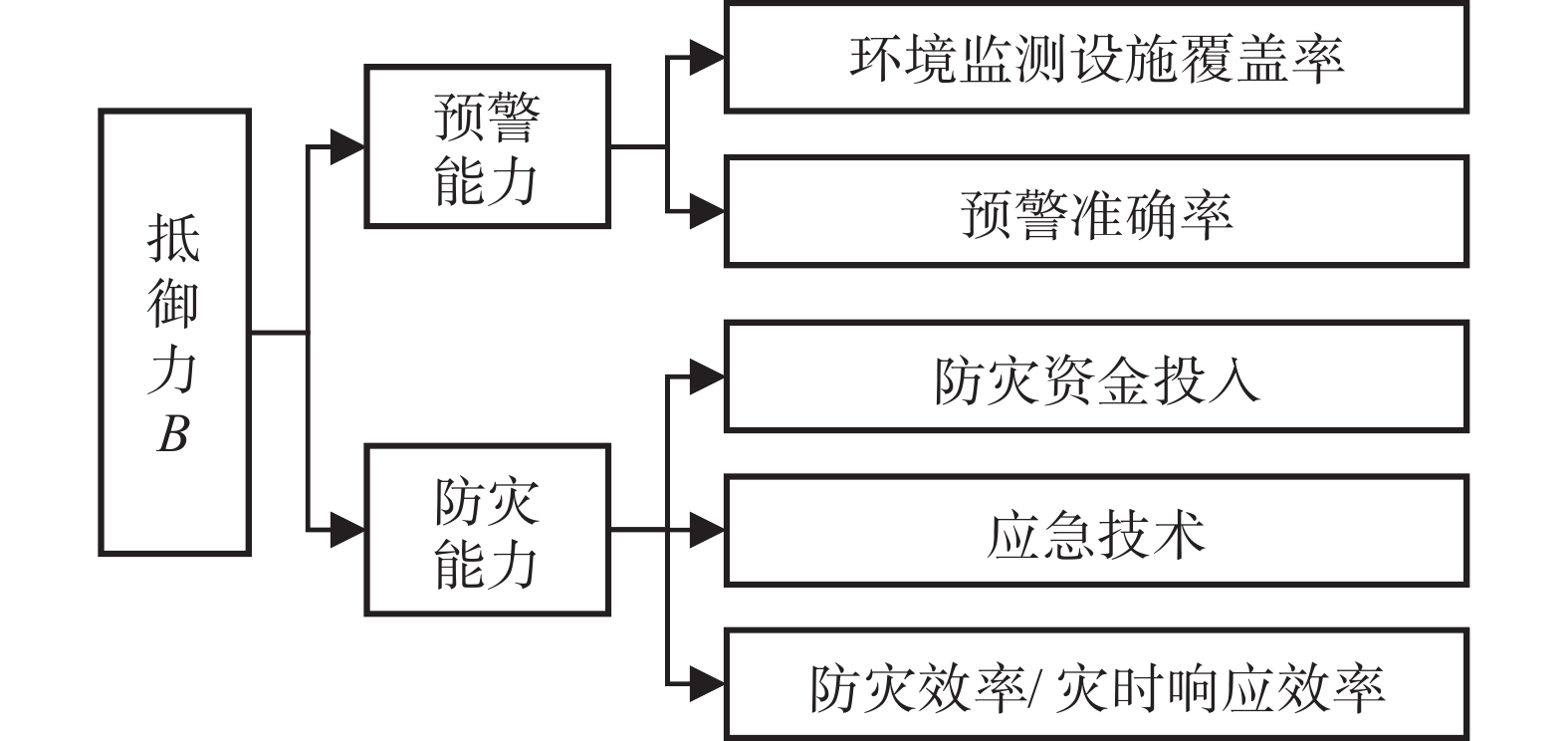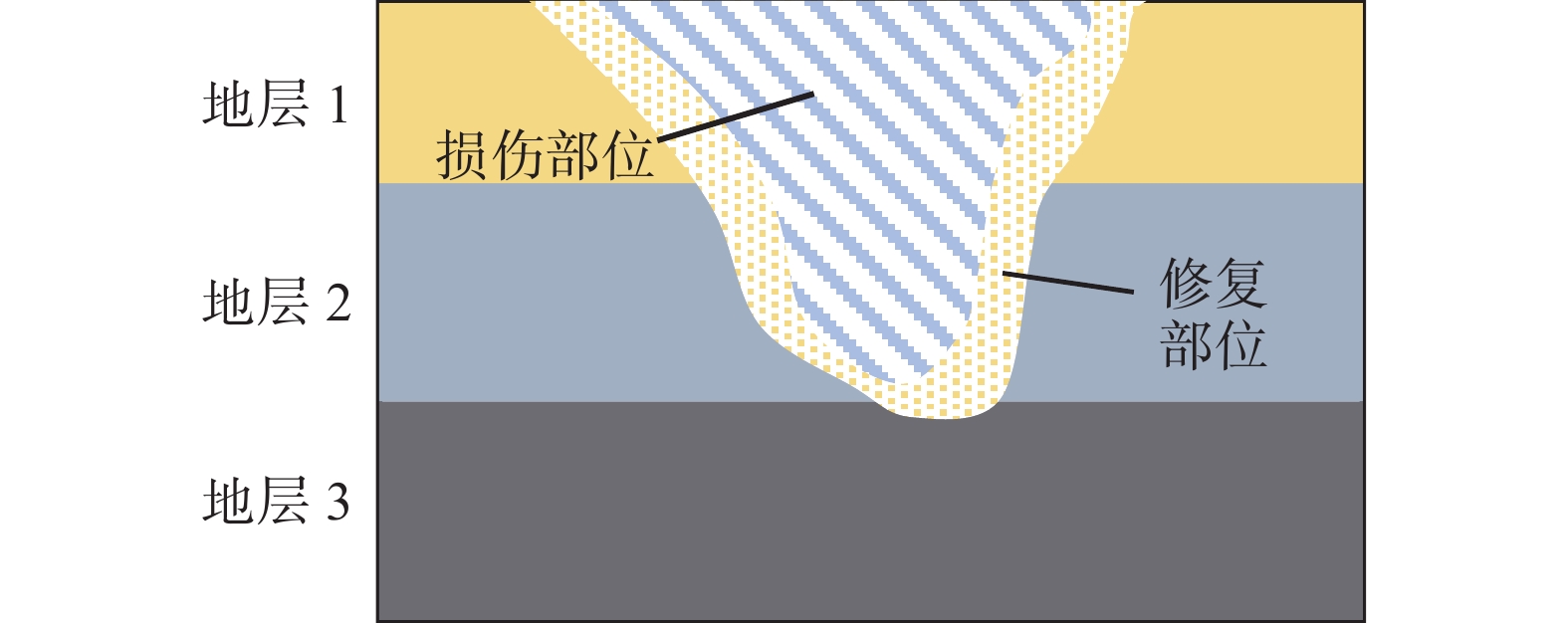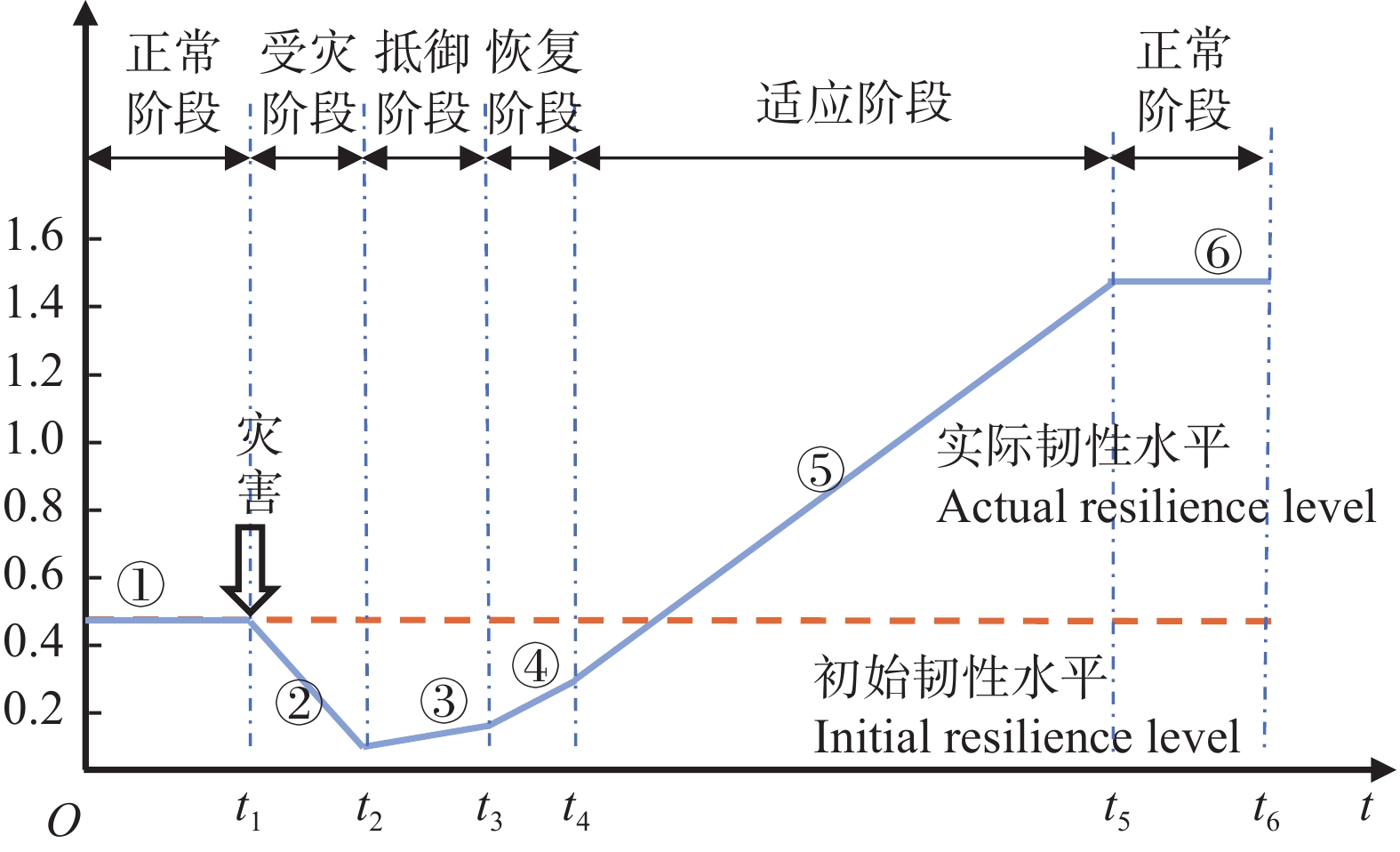Evaluation model of geological environment resilience in the urban deep underground space and its application
-
摘要:
研究目的 评估城市深层地下空间地质环境韧性有助于提高城市地下空间开发利用的安全性,减少灾害事件造成的经济损失。
研究方法 本文从城市深层地下空间的灾害事件严重度、地质体脆弱性、抵御力、恢复力和适应力等方面出发,建立了城市深层地下空间地质环境韧性多因素综合评估模型,并结合某城市一起突发事件的相关数据对评估模型进行了应用。
研究结果 评估模型具有较高操作性和可行性,可在各种复杂地质环境的城市中开展深层地下空间韧性评估工作;所评价灾害事件的严重度为5.601,属严重水平;地质体的暴露性为5.735,灾损敏感性为6.146,脆弱性综合评价结果为35.247,属脆弱地质体;预警能力指数为1.00,防灾能力指数由原来的5.66提高至灾后的7.00,故抵御力综合评价结果由15.38提高至19.02;通过填砂、地下注浆等措施后,恢复力为2.00,且由于地质环境趋于稳定,地质环境适应力综合分析为1.00。
结论 若受灾害影响,地质环境韧性水平的演化可分为正常、受灾、抵御、恢复、适应和新的正常水平6个阶段,韧性水平曲线呈现出先减小再增大后趋于稳定,且在受灾和抵御的节点处达到最小值。
Abstract:This paper is the result of urban geological survey engineering.
Objective Evaluating the geological environment resilience of urban deep underground space contributes to improving the safety of urban underground space during development and utilization, and reducing the economic losses caused by disasters.
Methods In this paper, a multi-factor integrated evaluation model for the geological environment resilience of urban deep underground space was proposed from the aspects of the severity of event, the vulnerability of geological body, the resistant ability, the restoring ability and the adaptability. The evaluation model was applied to analyze a catastrophic engineering accident in a city by virtue of the relevant data.
Results The evaluation model is highly operational and feasible, and can be used for resilience assessment of urban deep underground space with various complex geological environments. For the studied accident, the severity index of the event is 5.601, which is categorized as a severe level. The exposure index is 5.735, the sensitivity index to disaster damage is 6.146, and the vulnerability index is 35.247, so the geological body is vulnerable. The early warning capacity index is 1.00, the disaster prevention capability index is increased from 5.66 to 7.00, so the resistant index is increased from 15.38 to 19.02. The recovery is 2.00 after sand filling and grouting. The adaptability index is 1.00 because the geological environment tends to be stable.
Conclusions If affected by a disaster, the evolution in the geological environment resilience can be divided into six stages, i.e., the normal stage, the affected stage, the resisting stage, the recovering stage, the adapting stage and the new normal stage. The resilience curve shows a decrease and then an increase before reaching stable again. The resilience level reaches a minimum value at the turning point of the affected stage and the resisting stage.
-

-
图 7 地质剖面图与风井、地铁隧道、联络通道横截面(据Tan et al., 2021修改)
Figure 7.
表 1 韧性水平等级划分
Table 1. Classification of toughness levels
韧性水平 <0.05 0.05~0.1 0.1~0.4 0.4~1.0 >1.0 等级 极低 低 中等 高 极高 表 2 灾害事件影响分级
Table 2. Classification of disaster event impact
严重度指数D 1~2 2~4 4~6 6~9 影响 轻微 中等 严重 极严重 表 3 地质体脆弱性分级
Table 3. Classification of the vulnerability of geological body
脆弱性 <9 9~30 30~50 >50 等级 坚固 中等 脆弱 极脆弱 表 4 灾害事件严重度计算
Table 4. Calculation of disaster event severity
评估指标 分级标准 赋值量化 分级结果 赋值结果(x) 计算权重(w) 计算模型 地面沉降 <0.005 km2小型/0.005~0.1 km2中型/
0.1~1 km2 大型/>1 km2 特大型3/5
7/90.007 km2 5 0.085 $D = \sum\limits_{i = 1}^{{N_1}} {{w_i}{x_i}} $ 塌陷规模 小型:坑洞1~3处,S≤1 km2
中型:坑洞4~10处,S≤5 km2
大型:坑洞11~20处,S≤10 km2
特大型:坑洞>20处,S>10 km21
3
5
7小型 1 0.121 塌陷剖面形态特征 坛状/井状/漏斗状/碟状/不规则 1/3/5/7/9 漏斗状 5 0.143 压力水头变化量 <2 m/2~4 m/4~6 m/6~8 m/>10 m 1/3/5/7/9 4.7~6.6 m 7 0.272 岩土体承载力变化量 −5%/−10%/−30%/−50%/−80% 1/3/5/7/9 −80%以上 9 0.242 计算结果: 岩爆烈度等级 Ⅰ级/Ⅱ级/Ⅲ级/Ⅳ级 1/3/5/7 无岩爆 0 0.050 D = 5.601 突水规模 小型/中型/大型/特大型 1/3/5/7 中等突水点 3 0.086 其中:x为指标赋值结果;w为指标计算权重;N1值暴露性的指标数量。 表 5 地质体的脆弱性计算
Table 5. Calculation of vulnerability of geological bodies
评估指标 分级标准 赋值量化 分级结果 赋值结果(x) 计算权重(w) 计算模型 暴露性E 在建工程规模 小型/中型/大型 3/5/7 大型 7 0.548 $V = E \cdot M$ 在建工程密度 大/小/无 7/3/0 无在建工程 0 0.211 $ E = \sum\limits_{i = 1}^{{N_2}} {{w_i}{x_i}} $ $M = \sum\limits_{i = 1}^{{N_3}} {{w_i}{x_i}} $
压力水头可变
最大幅度<5 m/5~10 m/10~15 m/
15~20 m/>20 m1/3/5
7/9>20 m 9 0.241 损敏感性M 围岩等级 Ⅰ级/Ⅱ级/Ⅲ级
Ⅳ级/Ⅴ级、Ⅵ级1/3/5
7/9Ⅳ级 7 0.381 计算结果:
E=5.735,
M=6.146,
V=35.247岩土体承载力 >500 kPa
200~500 kPa
<200 kPa3
5
7<200 kPa 7 0.269 地层渗透系数 高渗透性/中渗透性/低渗透性 7/5/3 低渗透性 3 0.138 地层岩性 土体/软硬相间岩/土石混合体较硬岩/硬岩 9/7/5
3/1均由第四纪土体组成,
无岩石9 0.064 地应力状态 高地应力/中地应力/一般地应力 7/5/3 一般地应力 3 0.067 含水岩组富水性 极强富水性/强富水性/中等富水性
弱富水性/微富水性9/7/5
3/1中等富水性 5 0.081 注:x为指标赋值结果;w为指标计算权重;N2值暴露性的指标数量;N3指灾损敏感性指标数量。 表 6 抵御力计算
Table 6. Calculation of defense
评估指标 分级标准 赋值量化 分级结果 赋值结果(x) 计算权重(w) 计算模型 预警能力Wb 环境监测设施覆盖率/% / / / 100% / $B = {P_{\text{b}}} \times {e^{{W_{\text{b}}}}}$ 预警准确率/% / / / 100% / ${P_{\text{b}}} = \sum\limits_{i = 1}^{{N_4}} {{w_i}{x_i}} $ 防灾能力Pb 防灾资金投入 高/中/低 7/5/3 高 7 0.524 计算结果:
Pb= 5.66(7.00),
Wb = 1.00, B=15.38(19.02)应急技术 水平高/中等/水平低 7/5/3 水平高 7 0.141 防灾效率 高/中/低 7/5/3 低 3 0.335 灾时响应效率 高/中/低 7/5/3 高 7 注:x为指标赋值结果,w为指标计算权重,N4值防灾能力的指标数量。 表 7 恢复力计算
Table 7. Calculation of recovery
一级指标 二级指标 数值 计算模型 恢复力 损伤的地质体体积 11308.95 m³ $R = \frac{{{V_1}}}{{{V_2}}} \cdot \lg \left( {\frac{{{F_1}}}{{{F_2}}}} \right)$ 加强的地质体体积 20000 m³ 损伤前地质体承载力 100 kPa 计算结果 加强后地质体承载力 1.2 MPa R=2.09 注:V1为加强的地质体体积;V2为受灾地质体体积;F1为加强后的地质体承载力;F2为受灾地质体的承载力。 表 8 韧性水平计算结果
Table 8. Calculation results of toughness leve
时间 初始韧性水平 实际韧性水平 t1 0.436 0.436 t2 0.436 0.078 t3 0.436 0.096 t4 0.436 0.257 t5 0.436 1.441 t6 0.436 1.441 -
[1] Deng Rilang, Chen Lingwei, Cai Junjian, Zhang Huawei, Zheng Xianchang. 2022. Evaluation of collapse susceptibility based on a contribution rate model—A case study at baiyun district, guangzhou City[J]. Bulletin of Soil and Water Conservation, 42(4): 218−226, 381 (in Chinese with English abstract).
[2] Goldbeck N, Angeloudis P, Ochieng W Y. 2019. Resilience assessment for interdependent urban infrastructure systems using dynamic network flow models[J]. Reliability Engineering & System Safety, 188: 62−79.
[3] Gou Defei. 2020. Simulation Study on Optimal Operation Strategy of Drainage System of Deep Tunnel in S Area of Guangzhou[D]. Shenyang: Shenyang Jianzhu University, 1−130 (in Chinese with English abstract).
[4] Huang H W, Zhang D M. 2016. Resilience analysis of shield tunnel lining under extreme surcharge: Characterization and field application[J]. Tunnelling and Underground Space Technology, 51: 301−312. doi: 10.1016/j.tust.2015.10.044
[5] Huang Yajiang, Li Shuquan, Xiang Sisi. 2021. Evaluation of subway fire safety resilience based on AHP−PSO fuzzy combination weighting method[J]. Journal of Catastrophology, 36(3): 15−20, 40 (in Chinese with English abstract).
[6] Lan Wei, Wang Weidong, Chang Linyue. 2022. Field pumping test and soil layer deformation analysis of super large scale deep foundation pit engineering[J]. Rock and Soil Mechanics, 43(10): 2898−2910 (in Chinese with English abstract).
[7] Lei Shengxiang, Liu Zhichun, Huang Shuanglin, Du Kongze, Ding Zhengquan. 2022. Related research progress of networked expansion of urban underground space[J]. Chinese Journal of Underground Space and Engineering, 18(5): 1424−1440 (in Chinese with English abstract).
[8] Li Diyuan, Mo Qiuzhe. 2015. The utilization of urban underground space in Singapore and the lesson that could be learned by China[J]. Science & Technology Review, 33(6): 115−119 (in Chinese with English abstract).
[9] Li Hua, Wang Liang, Han Haodong, Yang Jian, Wang Qiao, Wang Donghui, Xi Zhenzhu, Long Xia, ZhangWei, Liao Guozhong. 2020. A new method for detecting gypsum mineral salt enriched layer of urban underground space in red bed area: A case study of Chengdu International Biological City[J]. Geology in China, 47(6): 1793−1803 (in Chinese with English abstract).
[10] Li Nianchun, Zhan Xueqiang, Fen Quanlin, Xu Qiuxiao, Li Hongtao, Hao Jie, Wu Di. 2021. Evaluation of bearing capacity of geological environment in shandong province based on "bearing foundation−bearing status−bearing potential" model[J]. Northwestern Geology, 54(1): 222−231 (in Chinese with English abstract).
[11] Lin Xingtao, Chen Xiangsheng, Su Dong, Zhu Min, Han Kaihang, Chen Renpeng. 2022. Evaluation method for resilience of shield tunnel linings considering multiple disturbances and its application[J]. Chinese Journal of Geotechnical Engineering, 44(4): 591−601 (in Chinese with English abstract).
[12] Liu Xingwang, Li Binghe, Chen Weilin, Mao Haihe, Zhang Ge, Sun Zhengbo. 2022. Control technology for the influence of deep and large foundation pit of 6−story basement in deep soft soil on adjacent subway tunnels[J]. Building Structure, 52(15): 136−141 (in Chinese with English abstract).
[13] Monstadt J, Schmidt M. 2019. Urban resilience in the making? The governance of critical infrastructures in German cities[J]. Urban Studies, 56(11): 2353−2371. doi: 10.1177/0042098018808483
[14] Pan Zongyuan, Jiang Xiaozhen, Dai Jianling, Guan Zhende, Wu Yuanbin. 2017. Study on the mechanism of groundwater level restoration process to karst sinkholes in karst deposit drainage area: A case of Dachengqiao, Ningxiang county, Hu’nan Province[J]. Carsologica Sinica, 36(6): 786−794 (in Chinese with English abstract).
[15] Sun Jun. 2019. Development and some issues on exploitation and utilization of urban underground space in China and abroad[J]. Tunnel Construction, 39(5): 699−709 (in Chinese with English abstract).
[16] Tan Y, Lu Y, Wang D. 2021. Catastrophic failure of shanghai metro line 4 in July, 2003: Occurrence, emergency response, and disaster relief[J]. Journal of Performance of Constructed Facilities, 35(1): 04020125. doi: 10.1061/(ASCE)CF.1943-5509.0001539
[17] Wang Hanbin. 2013. The Strategy Research on Urban Underground Space in High−density Area[D]. Tianjin: Tianjin University, 1−307(in Chinese with English abstract).
[18] Wang J, Deng Y, Qalati S A, Qureshi N A. 2022. Urban resilience and transportation infrastructure level in the yangtze river delta[J]. Frontiers in Environmental Science, 10: 893964. doi: 10.3389/fenvs.2022.893964
[19] Wei Qiang, Liu Jiaqi, Wang Jingchun, Wang Peng. 2021. Evaluation of safety resilience in tunnel construction based on ideal fuzzy matter element[J]. China Safety Science Journal, 31(8): 62−68 (in Chinese with English abstract).
[20] Xi Xi, Ding Zan, Ye Runqing, Niu Ruiqing. 2021. Evaluation of geological environment carrying capacity of Huangshi city based on FCE−AHP[J]. Journal of Natural Resources, 36(3): 646−658 (in Chinese with English abstract). doi: 10.31497/zrzyxb.20210309
[21] Xia Riyuan, Lu Haiping, Cao Jianwen, Zhao Liangjie, Wang Zhe, Luan Song. 2022. Characteristics of groundwater resources of karst areas in the Southern China and water resources guarantee countermeasures[J]. Geology in China, 49(4): 1139−1153 (in Chinese with English abstract).
[22] Yan Xuxian, Wang Junli, Fan Ling, Li Wenchao. 2022. Research on subway flood disaster from the perspective of resilient city—Based on Bow−Tie−Bayesian network model[J]. Journal of Catastrophology, 37(2): 36−43 (in Chinese with English abstract).
[23] Zhang Bin, Xu Nengxiong. 2019. Current status, trend and revelation of worldwide urban underground space development and utilization[J]. Earth Science Frontiers, 26(3): 48−56 (in Chinese with English abstract).
[24] Zhang Jie, Li Duo, Zhang Yun, Wei Aihua, Cheng Xin. 2021. Evaluation on the bearing capacity of geological environment based on optimized weights of game theory[J]. Science Technology and Engineering, 21(20): 8360−8365 (in Chinese with English abstract).
[25] Zhao Dongyue, Chen Changkun, Yi Liang, Lei Peng, Xu Lili. 2022. Research on comprehensive assessment model of urban resilience with multi−factor[J]. Journal of Safety Science and Technology, 18(5): 54−59 (in Chinese with English abstract).
[26] Zheng Gang, Cheng Xuesong, Zhou Haizuo, Zhang Tianqi, Yu Xiaoxuan, Diao Yu, Wang Ruozhan, Yi Fan, Zhang Wenbin, Guo Wei. 2022. Resilient evaluation and control in geotechnical and underground engineering[J]. China Civil Engineering Journal, 55(7): 1−38 (in Chinese with English abstract).
[27] Zheng Qiyu, Xia Xiaohe, Li Mingguang, Zhang Yangqing. 2020. Influence of dewatering in confined aquifers on wall deformation and ground settlements in deep excavation[J]. Journal of Shanghai Jiaotong University, 54(10): 1094−1100 (in Chinese with English abstract).
[28] Zhi Zemin, Chen Qiong, Zhou Qiang, Xia Xingsheng, Liu Fenggui. 2022. Evaluation of geo−environmental carrying capacity of counties along the sichuan-Xizang railway based on random forest[J]. Science Technology and Engineering, 22(24): 10451−10460 (in Chinese with English abstract).
[29] Zhou Yinghao, Wang Wenjie, Lu Xizhou, Wang Kangwei. 2022. Combination weighting prediction model and application of rock burst disaster based on game theory[J]. China Safety Science Journal, 32(7): 105−112 (in Chinese with English abstract).
[30] 邓日朗, 陈凌伟, 蔡俊坚, 詹华炜, 郑先昌. 2022. 基于贡献率模型的崩塌易发性评价——以广州市白云区为例[J]. 水土保持通报, 42(4): 218−226, 381.
[31] 苟德菲. 2020. 广州市S区深层隧道排水系统优化调度运行策略模拟研究[D]. 沈阳: 沈阳建筑大学, 1−130.
[32] 黄亚江, 李书全, 项思思. 2021. 基于AHP−PSO模糊组合赋权法的地铁火灾安全韧性评估[J]. 灾害学, 36(3): 15−20, 40.
[33] 兰韡, 王卫东, 常林越. 2022. 超大规模深基坑工程现场抽水试验及土层变形规律研究[J]. 岩土力学, 43(10): 2898−2910.
[34] 雷升祥, 刘志春, 黄双林, 杜孔泽, 丁正全. 2022. 城市地下空间网络化拓建相关研究进展[J]. 地下空间与工程学报, 18(5): 1424−1440.
[35] 李地元, 莫秋喆. 2015. 新加坡城市地下空间开发利用现状及启示[J]. 科技导报, 33(6): 115−119.
[36] 李华, 王亮, 韩浩东, 杨剑, 王桥, 王东辉, 席振铢, 龙霞, 张伟, 廖国忠. 2020. 红层地区城市地下空间膏盐富集层探测新方法——以成都市国际生物城为例[J]. 中国地质, 47(6): 1793−1803.
[37] 李念春, 张学强, 冯泉霖, 徐秋晓, 李洪涛, 郝杰, 吴迪. 2021. 基于“承载基础−承载现状−承载潜力”模型的山东省地质环境承载力评价[J]. 西北地质, 54(1): 222−231.
[38] 林星涛, 陈湘生, 苏栋, 朱旻, 韩凯航, 陈仁朋. 2022. 考虑多次扰动影响的盾构隧道结构韧性评估方法及其应用[J]. 岩土工程学报, 44(4): 591−601.
[39] 刘兴旺, 李冰河, 陈卫林, 毛海和, 张戈, 孙政波. 2022. 深厚软土6层地下室深大基坑对邻近地铁隧道影响控制技术[J]. 建筑结构, 52(15): 136−141.
[40] 潘宗源, 蒋小珍, 戴建玲, 管振德, 吴远斌. 2017. 岩溶矿床疏干区地下水位恢复对岩溶塌陷作用机制的研究——以湖南宁乡大成桥为例[J]. 中国岩溶, 36(6): 786−794.
[41] 孙钧. 2019. 国内外城市地下空间资源开发利用的发展和问题[J]. 隧道建设(中英文), 39(5): 699−709.
[42] 万汉斌. 2013. 城市高密度地区地下空间开发策略研究[D]. 天津: 天津大学, 1−307.
[43] 魏强, 刘加奇, 王景春, 王鹏. 2021. 基于理想模糊物元的隧道施工安全韧性评估[J]. 中国安全科学学报, 31(8): 62−68.
[44] 席茜, 丁赞, 叶润青, 牛瑞卿. 2021. 基于FCE-AHP的黄石市地质环境承载力评价[J]. 自然资源学报, 36(3): 646−658.
[45] 夏日元, 卢海平, 曹建文, 赵良杰, 王喆, 栾崧. 2022. 南方岩溶区地下水资源特征与水资源保障对策[J]. 中国地质, 49(4): 1139−1153.
[46] 闫绪娴, 王俊丽, 范玲, 李文超. 2022. 韧性城市视角下地铁洪涝灾害风险分析——基于Bow1−Tie—贝叶斯网络模型[J]. 灾害学, 37(2): 36−43.
[47] 张彬, 徐能雄, 戴春森. 2019. 国际城市地下空间开发利用现状、趋势与启示[J]. 地学前缘, 26(3): 48−56.
[48] 张杰, 李铎, 张赟, 魏爱华, 程鑫. 2021. 基于博弈论优化权重的地质环境承载力评价[J]. 科学技术与工程, 21(20): 8360−8365.
[49] 赵冬月, 陈长坤, 易亮, 雷鹏, 许丽丽. 2022. 城市韧性多因素综合评估模型研究[J]. 中国安全生产科学技术, 18(5): 54−59.
[50] 郑刚, 程雪松, 周海祚, 张天奇, 于晓旋, 刁钰, 王若展, 衣凡, 张文彬, 郭伟. 2022. 岩土与地下工程结构韧性评价与控制[J]. 土木工程学报, 55(7): 1−38.
[51] 郑启宇, 夏小和, 李明广, 张扬清. 2020. 深基坑降承压水对墙体变形和地表沉降的影响[J]. 上海交通大学学报, 54(10): 1094−1100.
[52] 支泽民, 陈琼, 周强, 夏兴生, 刘峰贵. 2022. 基于随机森林的川藏铁路沿线县域地质环境承载力评价[J]. 科学技术与工程, 22(24): 10451−10460.
[53] 周英豪, 王文杰, 卢西洲, 王康伟. 2022. 岩爆灾害博弈论组合赋权预测模型及应用[J]. 中国安全科学学报, 32(7): 105−112.
-



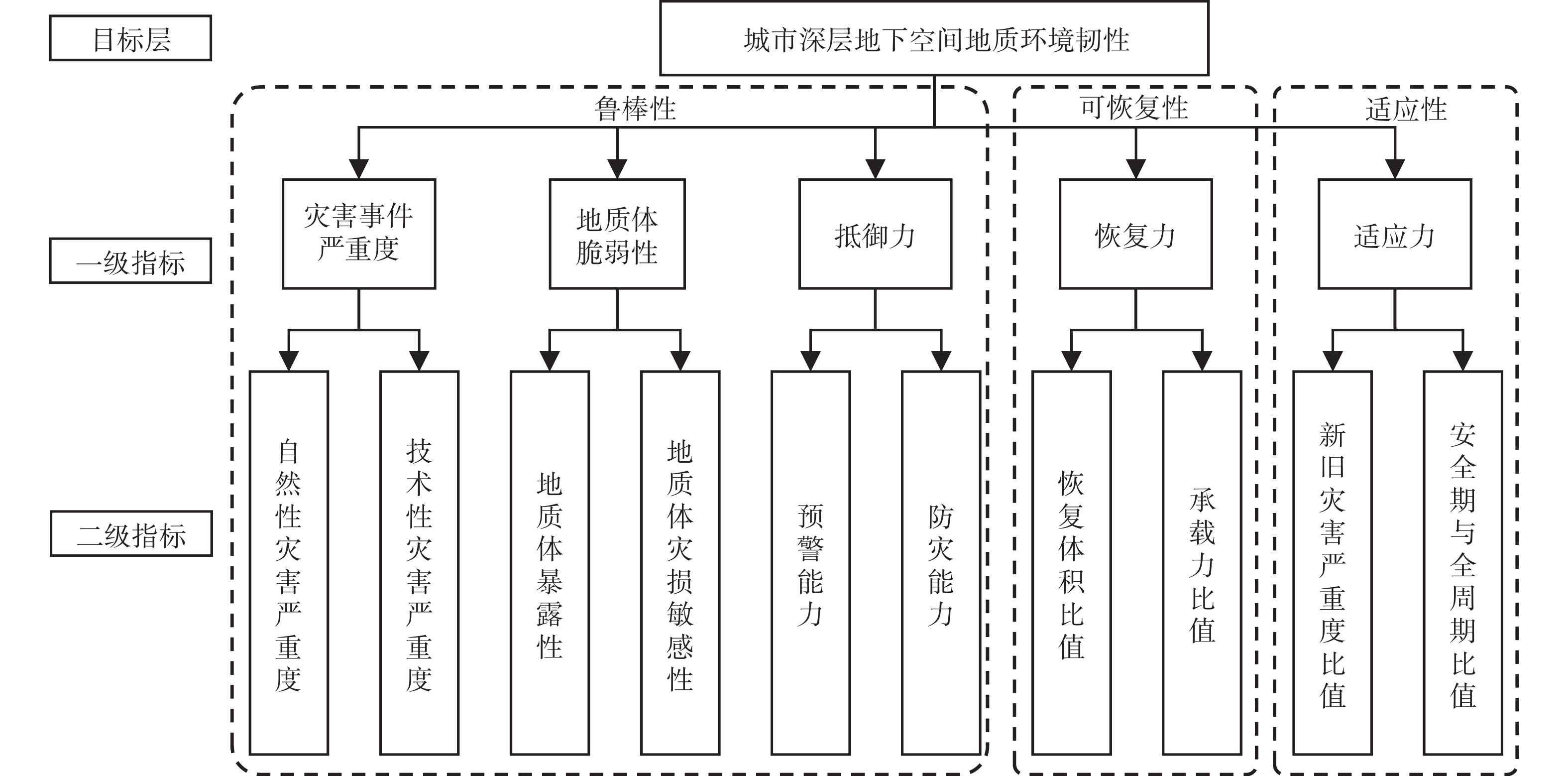
 下载:
下载:
